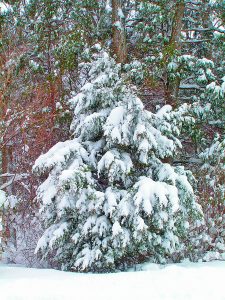In spring, summer, and fall, the rolling landscape that forms the Virginia Piedmont is provocatively and suggestively decked out in fancy foliage and fashionable colors, from the pastels of spring to the dark hues of autumn. But after the last leaves fall, the land is not simply disrobed, as in human nakedness. Rather, the land can be said to be like a nude, perhaps the oldest and most beautiful art form in the Western tradition. As Lord Kenneth Clark, the art historian, famously pointed out, to be naked is to be deprived of clothes, implying embarrassment and shame, while a nude is a work of art.

juniperus virginiana (eastern red cedar) with heavy snow load
More practically, wintertime is when you can see, really see, the lay of the land. It’s the one true time, most realtors will tell you, that you can actually see what you’re buying if what you’re buying is raw, undeveloped land. Rock ledges, ridges, and swales—at other times blurred and camouflaged—suddenly leap into view. And their lines are stark and clean, evoking a purity to the vision that is reminiscent of the nude Greek gods in ancient statutes.
There is, too, of course, a whisper of death in the winter landscape, but that is not without its own transcendent beauty. Certain wild creatures that have not gone to ground or headed south can be heard or seen in the rustling, fallen leaves. And you don’t have to believe in Greek gods to know, as surely as the sun rises every morning, that in just a few short weeks spring will reawaken everything. The world will be reborn.
In the meantime, you get to glimpse the afterlife in skeletal trees and decomposing stalks. Moreover, your aesthetic sense becomes more expansive when you realize that a plant’s structure, form, and texture are perhaps even more important than its color. The sculptural remains of dead and dormant plants in midwinter stand out in peaceful, subtle, and stately contrast to the mostly monochromatic background palette of browns and grays. In this context, the flamboyant display of color that comes with flowers in the spring can seem almost pornographic.
Evergreens, of course, inject some color into the winter landscape, but it is a green so dark and somber that it seems almost funeral-like black. The Virginia cedar stands out, not because of its often diminutive height and statue or even its pleasant aroma, but because it’s everywhere, like Christmas ornaments, decorating the landscape. Along fence lines, in any uncut field, at woodland’s edge, they’re ubiquitous.
Formally called the Juniperus virginiana, it’s also known as the eastern red-cedar, red cedar, eastern juniper, red juniper, pencil cedar, or aromatic cedar. The Native American name means “redwood.” European settlers first took note of it on Roanoke Island, in 1564, and it became prized—because of its resistance to insects and weather—by colonists for building furniture, rail fences, and log cabins.
But nowadays it’s often considered a weed tree because it is so hardy and prolific. In ecological succession, it is a “pioneer invader,” meaning it is one of the first trees to repopulate cleared, eroded, or otherwise damaged land. Because it is resistant to extremes of drought, heat, and cold and can grow well in all types of soil (rocky, sandy, clay), it is a Darwinian survivor, often living for hundreds of years. During the 1930s Dust Bowl, farmers were encouraged to plant eastern juniper to create wind breaks. Perhaps the only negative that can be said of the tree is that, as an alternate host for the fungal disease known as cedar-apple rust, it should not be allowed to grow near apple orchards.
Birds are especially fond of the small bluish berries produced by the cedar. These seeds pass through the birds’ guts in just a few minutes, and the seeds consumed by birds have levels of germination roughly three times higher than the uneaten seeds. As the birds digest their meal, they often sit on fences. No wonder so many brand new cedar trees can be spotted growing along just about any Piedmont fenceline.
Yes, the winter landscape invites observation and contemplation.
— Walter Nicklin
Leave a Reply